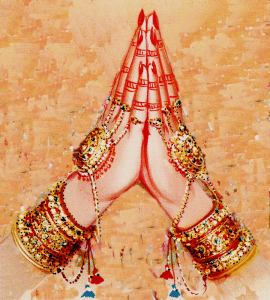In our culture, marriage symbolizes not just the sacred union of two individuals, but of the coming together of two families and extended families as well! Their level of involvement is so profound that typically the family decides the bride/groom.
- Mangni or Nischitartham : Months before the wedding an engagement ceremony, known as Mangni (in North India) or Nischitartham (in South India), is held. The two families meet to perform rituals to make the engagement official. A muhurat (auspicious date & time) for the wedding is decided based on horoscopes. The couple is then blessed by elders of both families, and is given gifts including jewelry and clothing by their new family. In certain traditions, engagement is marked by the exchange of rings between the bride and groom to be.
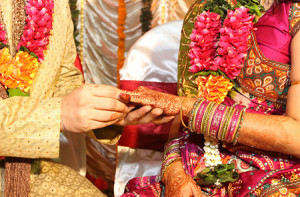
- Haldi Bath and Mehendi Ceremony : Traditional Indian weddings last a week, and start with pre-wedding ceremonies. Haldi is a ritual holy bath during which turmeric (Haldi), oil and water is applied to both the bride and groom by married women. This is followed by Mehendi ceremony, during which the bride’s hands and feet are decorated with intricate patterns by the application of Henna. On a lighter note, it is believed that, deeper the color of the mehendi (henna) stronger is the groom’s love for the bride.
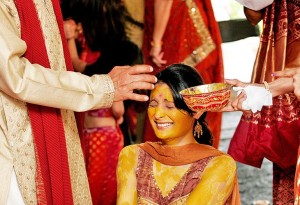
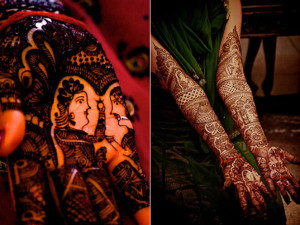
- Sangeet : Other important North-Indian prewedding ceremonies include Sangeet, and Tilak. Sangeet means music. As the name suggests, this function is an evening of musical entertainment and merriment hosted by the bride’s family. The main significance of this ceremony is that the bride is introduced to all the members of her new family. As a part of the Tilak ceremony, vermillion or kumkum is placed on the forehead of the groom by all the male members of the bride’s family. Kumkum is a sign of auspiciousness. Presents are given to the groom and his family, requesting them to take care of the bride.
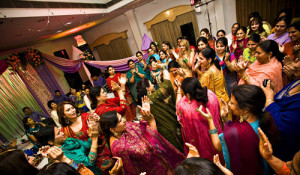
- Janavasam : Janavasam is a predominantly south Indian tradition, where the groom is paraded around the town on a chariot (or nowadays a open car!), the evening before the wedding.
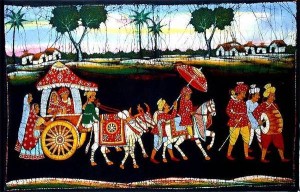
- Jaimala : The actual wedding ceremony itself is around 3 hours long, not including many other smaller rituals before and after the muhurat (auspicious time). The wedding is usually held at the bride’s home or a wedding hall. The arrival of the groom is an important and fun-filled event. The groom, dressed in his wedding attire, leaves his home to the wedding venue on a decorated ghodi (horse) or for the more extravagant, on a decorated elephant! Along with the groom sits his ‘best man’ usually a younger brother, cousin or nephew who acts as his caregiver. However, these days, these customs are not seen any more as most grooms like to travel by luxury cars.
- At the wedding venue, the bride waits for the groom, with a Jaimala/Varamala, which is a decorated garland. Soon after the groom arrives, the bride and groom exchange garlands. On a lighter note, it is considered that, whoever puts the garland first on their partner, will have an upper hand in the marriage.
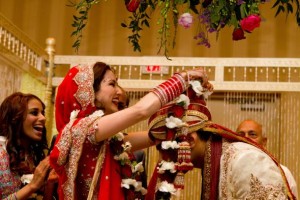
- Baasi Jawari : Another popular north Indian tradition is Baasi Jawari or Joothe Churana (stealing the shoes). The bride’s sisters hide the groom’s shoes, and demand the groom money to have them returned. Apart from all the fun, many pujas (prayers) are performed by the bride and the groom on the day of the wedding. The bride does a Gowri puja (worshipping the Indian goddess Parvathi), and the groom does a Ganesh puja (worshipping the elephant headed Indian deity Ganesha), to gain their blessings, so that the entire wedding runs smoothly without any hurdles.
- Wedding Ceremony : The bride and groom are considered wed when the groom ties a mangalsutram/thali which is a sacred thread that symbolizes his promise to take care of the bride as long as he lives. The groom ties three knots when he ties the Thali, symbolizing the gods Brahma, Vishnu and Maheshwara. The entire wedding is done around an Agni Homam (sacred fire). Agni (fire god) is considered as the main witnesses to the marriage. The bride and the groom then circle the fire seven times, in a clockwise direction, called Saat Phere which signifies seven goals of married life which include religious and moral duties, prosperity, spiritual salvation and liberation, and sensual gratification. The bride leads the Pheres first and then the groom leads them, signifying equality of the two partners and their determination to stand beside each other though happiness and sorrow.
-
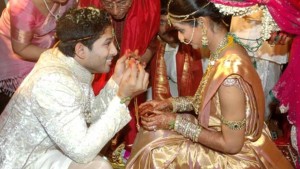
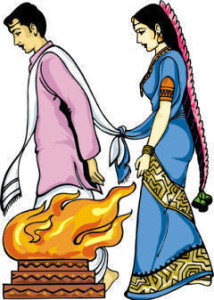
- The wedding culminates with the groom applying vermillion or kumkum to the bride’s forehead, welcoming her as his partner for life. This is the first time that kumkum is applied to the forehead of woman, when the bridegroom himself adorns her with it. In South-India, this is usually followed by the groom putting toerings on the bride. The kumkum, the mangalsuthram and the toe-rings symbolize a married woman.
-
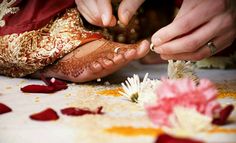
- South Indian weddings also have a ceremony where the groom shows the Arundhati Nakshatram (a subtle star in the Ursa Major constellation) to the bride. Historically, Arundhati was the wife of Sage Vashishta, and was considered to be the chastest of all women. It is believed that by seeing the Arundhati star, the bride will be as chaste as Arundhati herself.
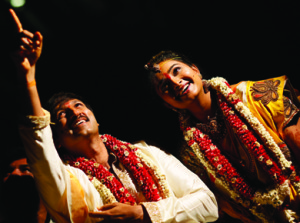
- Lightening of Mood through Games : Some wedding traditions also include wedding games for the couple to lighten the mood. In one such game they are to retrieve a ring from a pot of colored water, and this is done thrice to decide the winner. In another game, the bride and groom work together, to untie a ball of knots, using only one hand each. This symbolizes their perseverance in resolving together, issues that might come up in life. Other games include breaking papad on each other’s head, playing with a ball of flowers.
-
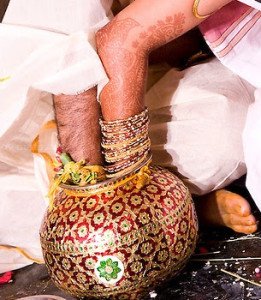
- Post Wedding Ceremony : After the wedding ceremony is over, the bride is bid farewell as she leaves for her husband’s house. This is a very emotional moment for the bride and her family, as she is leaving her parent’s family to join her husband’s. In some traditions, the couple goes first to the bride’s house, and after a few days leaves for the groom’s. In olden days, the bride used to be carried to the groom’s house in a doli (palanquin). Upon arrival at the groom’s house the newly-wed couple is greeted at the doorstep with Aarti to ward off bad spirit. The bride then topples a kalash (metal pot) of rice with her right leg. Following this, the couple enters the house, taking the first step with the right leg. In some traditions, the bride steps into a plate of vermillion mixed in water, and walks down to the prayer room. All this constitutes the grihapravesh (griha – house, pravesh – entry) ceremony. The bride and groom then perform Satyanarayana puja (prayer) showing their gratitude to the lord.

- Reception : The bride and the groom’s side hold a reception for family and friends. They may combine it with the wedding or may hold it separately. This event is non-ritualistic. People come to offer their greetings to the newly wedded couple.
With so much of color, vibrancy, food, people, rituals, music, fun and frolic, the Indian wedding is truly a festival in itself!
